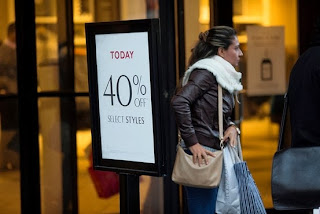When shoppers head out in search of Black Friday bargains this week, they won't just be going to the mall, they'll be witnessing retail theater.
 Stores will be pulling out the stops on deep discounts aimed at drawing customers into stores. But retail-industry veterans acknowledge that, in many cases, those bargains will be a carefully engineered illusion.
Stores will be pulling out the stops on deep discounts aimed at drawing customers into stores. But retail-industry veterans acknowledge that, in many cases, those bargains will be a carefully engineered illusion.
The common assumption is that retailers stock up on goods and then mark down the ones that don't sell, taking a hit to their profits. But that isn't typically how it plays out. Instead, big retailers work backward with their suppliers to set starting prices that, after all the markdowns, will yield the profit margins they want.
The red cardigan sweater with the ruffled neck on sale for more than 40% off at $39.99 was never meant to sell at its $68 starting price. It was designed with the discount built in. (...)
Here's how it works, according to one industry consultant describing an actual sweater sold at a major retailer. A supplier sells the sweater to a retailer for roughly $14.50. The suggested retail price is $50, which gives the retailer a roughly 70% markup. A few sweaters sell at that price, but more sell at the first markdown of $44.99, and the bulk sell at the final discount price of $21.99. That produces an average unit retail price of $28 and gives the store about a 45% gross margin on the product.
Retailers didn't always price this way. It used to be that most items were sold at full price, with a limited number of sales to clear unsold inventory. That began to change in the 1970s and 1980s, when a rash of store openings intensified competition and forced retailers to look for new ways to stand out.
 Stores will be pulling out the stops on deep discounts aimed at drawing customers into stores. But retail-industry veterans acknowledge that, in many cases, those bargains will be a carefully engineered illusion.
Stores will be pulling out the stops on deep discounts aimed at drawing customers into stores. But retail-industry veterans acknowledge that, in many cases, those bargains will be a carefully engineered illusion.The common assumption is that retailers stock up on goods and then mark down the ones that don't sell, taking a hit to their profits. But that isn't typically how it plays out. Instead, big retailers work backward with their suppliers to set starting prices that, after all the markdowns, will yield the profit margins they want.
The red cardigan sweater with the ruffled neck on sale for more than 40% off at $39.99 was never meant to sell at its $68 starting price. It was designed with the discount built in. (...)
Here's how it works, according to one industry consultant describing an actual sweater sold at a major retailer. A supplier sells the sweater to a retailer for roughly $14.50. The suggested retail price is $50, which gives the retailer a roughly 70% markup. A few sweaters sell at that price, but more sell at the first markdown of $44.99, and the bulk sell at the final discount price of $21.99. That produces an average unit retail price of $28 and gives the store about a 45% gross margin on the product.
Retailers didn't always price this way. It used to be that most items were sold at full price, with a limited number of sales to clear unsold inventory. That began to change in the 1970s and 1980s, when a rash of store openings intensified competition and forced retailers to look for new ways to stand out.
by Suzanne Kapner, WSJ | Read more:
Image: Claudio Papapietro for The Wall Street Journal